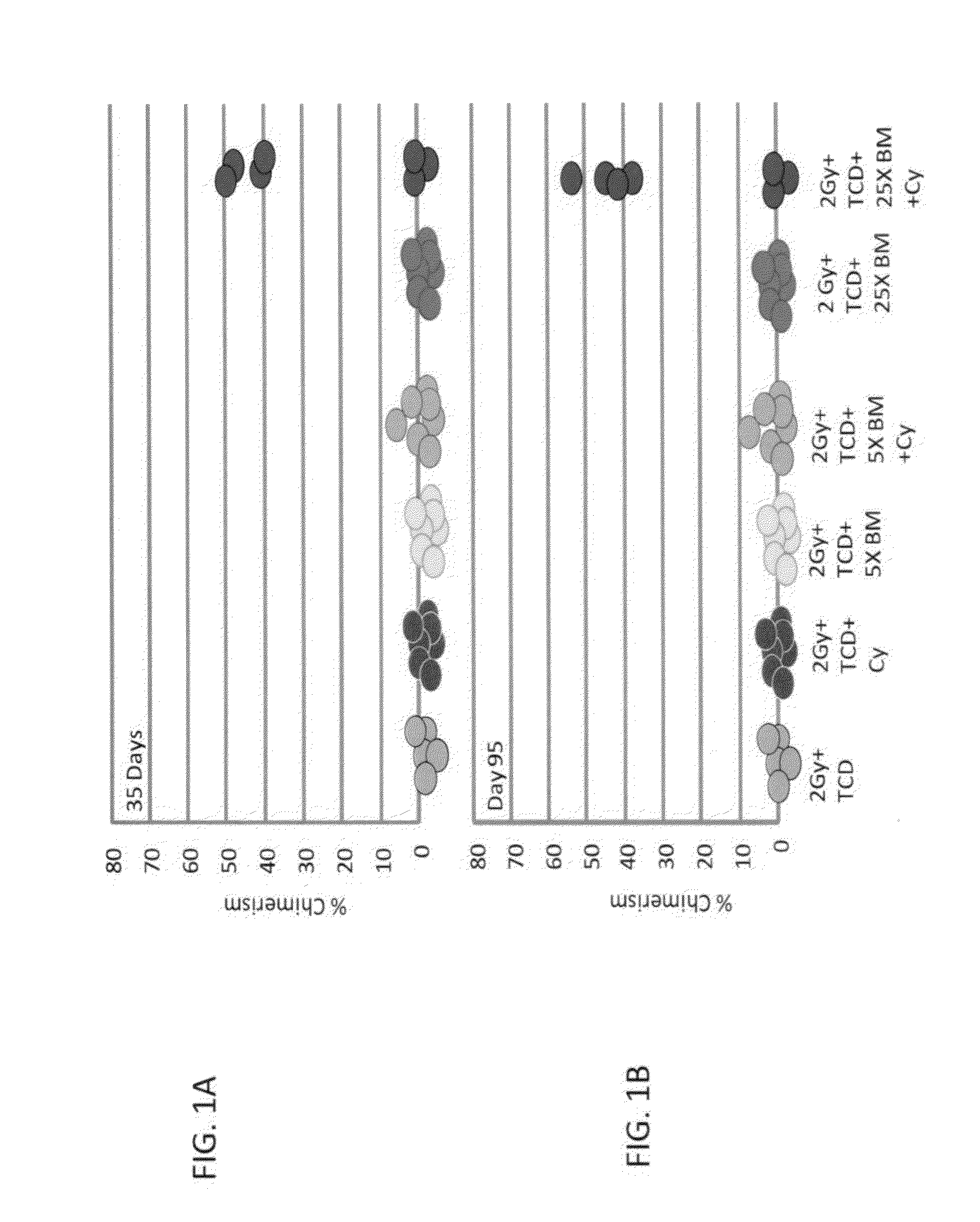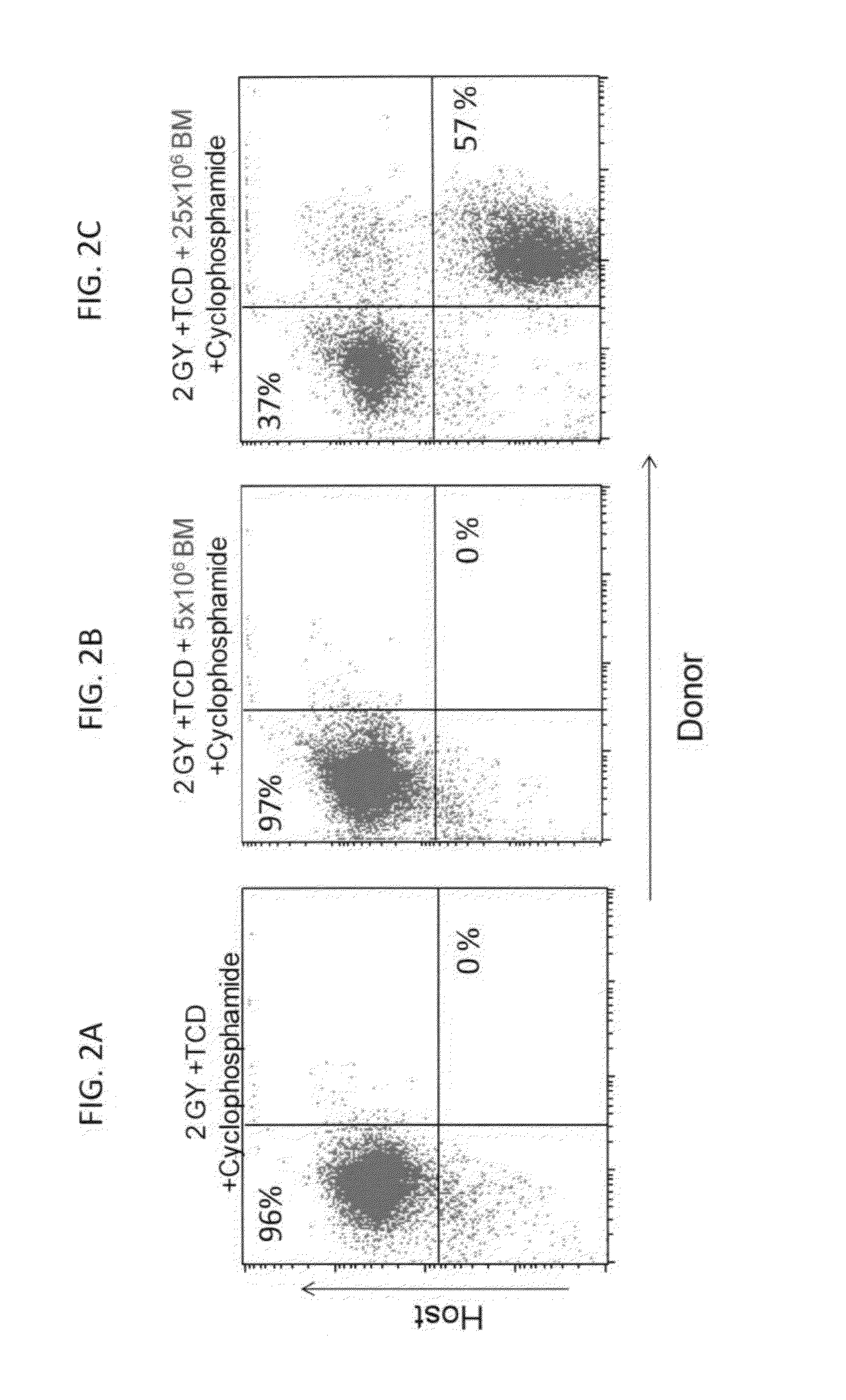Combination therapy for a stable and long term engraftment using specific protocols for t/b cell depletion
a technology of t/b cell depletion and t/b cell depletion, which is applied in the field of conjugation therapy for, can solve the problems of opportunistic infections, slow recovery rate of the recipient's immune system, and complex haploidentical transplantation under ri
- Summary
- Abstract
- Description
- Claims
- Application Information
AI Technical Summary
Benefits of technology
Problems solved by technology
Method used
Image
Examples
example 1
Stable Engraftment of HLA Mismatched Bone Marrow Following Transplantation of ‘Mega Dose’ Bone Marrow and Post Transplantation Cyclophosphamide
Materials and Experimental Procedures
Animals
[0321]Mice used in these studies were 6-12 week old female mice. Balb / c-Nude (H-2d) and C3H / Hen (H-2k) were purchased from Harlan Israel (Rehovot, Israel). All mice were kept in small cages (5 animals in each cage) and fed sterile food and acid water. These studies were approved by the Weizmann Institute of Science, Institutional Animal Care and Use Committee.
[0322]Transplantation Protocol
[0323]Low (5×106) and high dose (25×106) Balb / c-Nude BM cells (providing a source of BM depleted of T cells) were transplanted into allogeneic recipients (C3H / Hen) on day 0 following in-vivo T cell debulking (TCD) with anti-CD4 (clone GK1.5) and anti-CD8 (clone 53.6.72) antibodies (300 μg each; Bio X Cell, NH, USA) delivered on day −6, and exposure to 2.0 Gy total body irradiation (TBI) on day −1. High dose Cycloph...
example 2
The Effect of Different Doses of Total Body Irradiation (TBI) on Chimerism
Materials and Experimental Procedures
Animals
[0335]As described in Example 1, hereinabove.
[0336]Transplantation Protocol
[0337]High dose (25×106) Balb / c-Nude BM cells (providing a source of BM depleted of T cells) were transplanted into allogeneic recipients (C3H / Hen) on day 0 following in-vivo T cell debulking (TCD) with anti-CD4 (clone GK1.5) and anti-CD8 (clone 53.6.72) antibodies (300 μg each; Bio X Cell, NH, USA) delivered on day −6, and exposure to different doses of irradiation ranging from 1 to 3.5 Gy TBI on day −1. High dose Cyclophosphamide (CY, 100 mg / kg, Baxter Oncology, Germany) was administered on days +3 and +4 post transplant and donor type chimerism was evaluated 30 days post transplant using fluorescein anti-host and donor H-2 antibodies (e.g. FITC labeled anti-H-2Dd antibody specific for donor type cells and PE labeled anti-H-2Kk antibody specific for host type cells).
[0338]Results
[0339]In thi...
example 3
The Effect of Different Cyclophosphamide (CY) Doses on Chimerism
Materials and Experimental Procedures
Animals
[0342]As described in Example 1, hereinabove.
[0343]Transplantation Protocol
[0344]High dose (25×106) Balb / c-Nude BM cells (providing a source of BM depleted of T cells) were transplanted into allogeneic recipients (C3H / Hen) on day 0 following in-vivo T cell debulking (TCD) with anti-CD4 (clone GK1.5) and anti-CD8 (clone 53.6.72) antibodies (300 μg each; Bio X Cell, NH, USA) delivered on day −6, and exposure to 2.0 Gy total body irradiation (TBI) on day −1. Different doses of Cyclophosphamide (CY, 100 mg / kg, 125 mg / kg or 150 mg / kg, Baxter Oncology, Germany) were administered on days +3 and +4 post transplant and donor type chimerism was evaluated 30 days post transplant using fluorescein anti-host and donor H-2 antibodies (e.g. FITC labeled anti-H-2Dd antibody specific for donor type cells and PE labeled anti-H-2Kk antibody specific for host type cells).
[0345]Results
[0346]In thi...
PUM
| Property | Measurement | Unit |
|---|---|---|
| time | aaaaa | aaaaa |
| time | aaaaa | aaaaa |
| pH | aaaaa | aaaaa |
Abstract
Description
Claims
Application Information
 Login to View More
Login to View More - R&D
- Intellectual Property
- Life Sciences
- Materials
- Tech Scout
- Unparalleled Data Quality
- Higher Quality Content
- 60% Fewer Hallucinations
Browse by: Latest US Patents, China's latest patents, Technical Efficacy Thesaurus, Application Domain, Technology Topic, Popular Technical Reports.
© 2025 PatSnap. All rights reserved.Legal|Privacy policy|Modern Slavery Act Transparency Statement|Sitemap|About US| Contact US: help@patsnap.com



